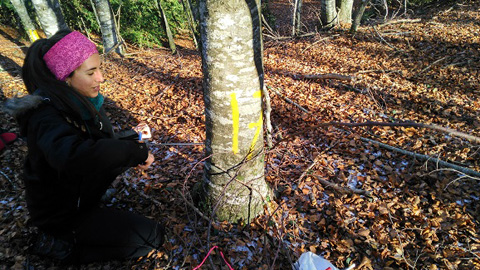New forests grow faster but are more vulnerable to climate change

11/10/2019
During the 20th century, the rural exodus left many abandoned farmlands and meadows, especially across the European Mediterranean. These lands are now covered with trees, a slow process which continues until today and which has given way to what is known as "new forests". What role do these forests play? Can they be an alliance in the fight against climate change?
A recent study published in the journal Agricultural and Forest Meteorology and led by CREAF researchers Raquel Alfaro-Sánchez and Josep Maria Espelta, demonstrates that these new forests grow faster than already existing ones, after deducting the age and density of the forest. A total of 32% faster. And that is very good news. In order to grow faster, the trees capture more CO2 from the environment and could contribute to mitigate the excess of this gas in the atmosphere. According to the study, one of the reasons causing this increase in growth is the land they stand on. The new forests have inherited more fertile soils due to the farming and livestock rearing activities they were used for in the past.
To conduct the study, the research team extracted samples from young (planted after 1950) and pre-existing (before 1950) common beech trees in the Osona and Ripollès regions. The rings of these trees were key to establish the growth; the wider the rings the more growth had been accumulated in the same period of time.
The research team strived to discover more and probed into whether a more rapid growth implied some type of negative effect, especially in an ever-changing climate as the one existing today. The result was clear, this rapid growth represents lower wood density, up to 3% less. "Less density means that the trees will be in a worse situation when facing extreme climate conditions such as droughts and other phenomena such as plagues and strong winds", comments researcher and lead author Raquel Alfaro.
“At the moment, the 'new beech groves' respond very well during years of abundant rains and this prepares them for when they must resist worse conditions such as droughts. Nevertheless, this effect can diminish or even disappear if the frequency of droughts increases, a situation we will probably see in the future", affirms Josep Maria Espelta, CREAF coordinator of the project. If this is the case, the ecosystem services provided by these "recent" forests will have been very transitional. In this sense, there will be a need for forestry management to take into account the possible differences between new and pre-existing forests with the aim of guaranteeing their conservation in a climate crisis scenario as the one existing today.
This project was conducted under the framework of the SPONFOREST project, funded by the EU and with the participation of researchers Joan Pino and Oihane Díaz Nogales from the Universitat Autònoma de Barcelona, as well as researchers from the University of Stirling.
Original article:
Alfaro-Sánchez, R., Jump, A. S., Pino, J., Díez-Nogales, O., & Espelta, J. M. (2019). Land use legacies drive higher growth, lower wood density and enhanced climatic sensitivity in recently established forests. Agricultural and Forest Meteorology, 276, 107630.